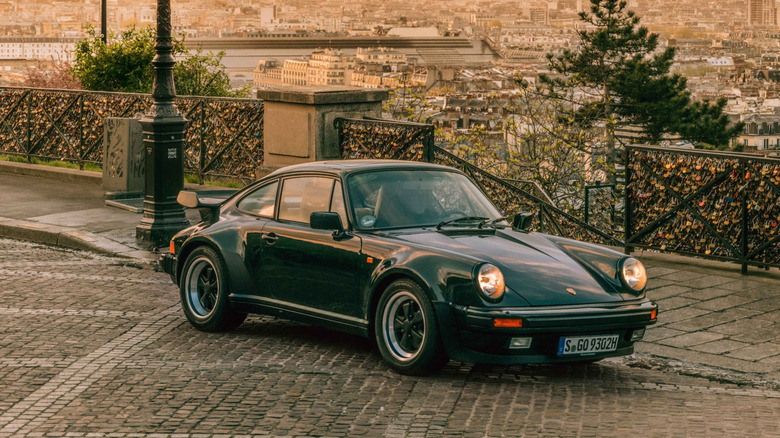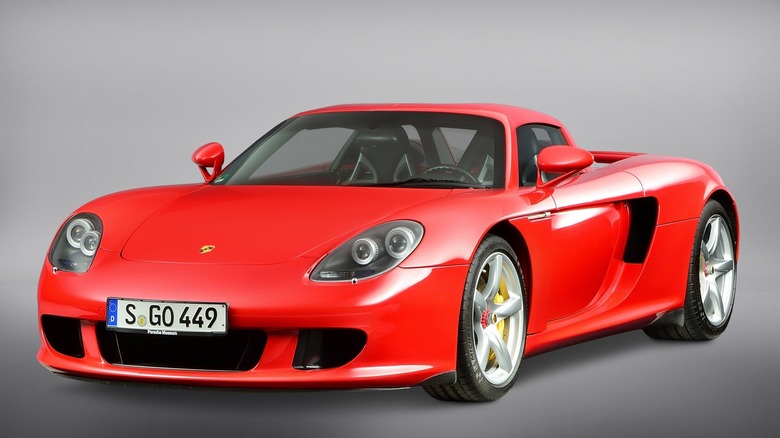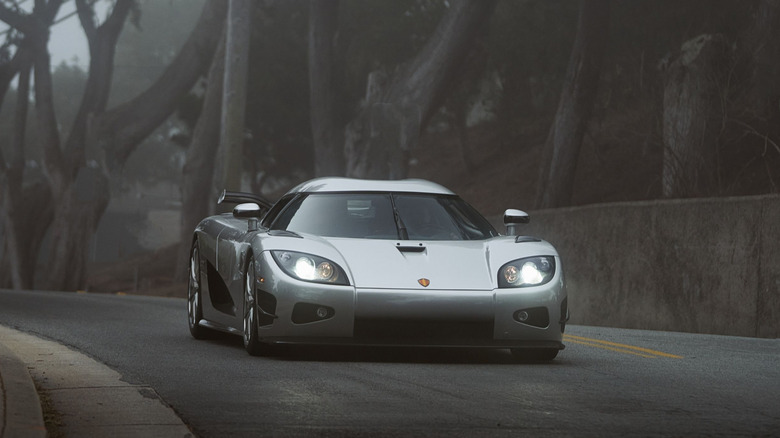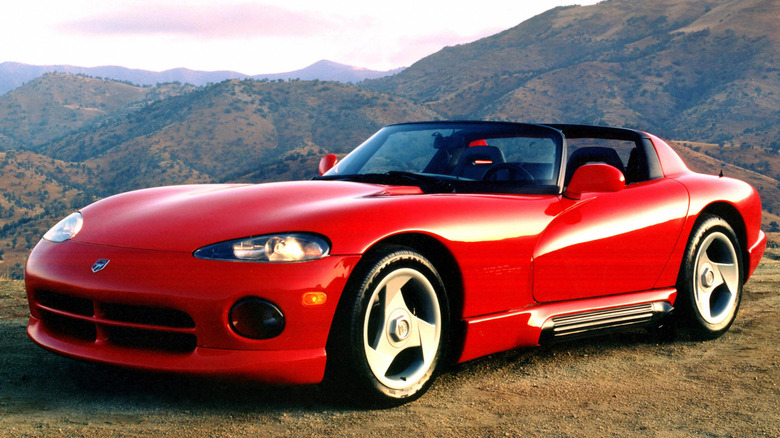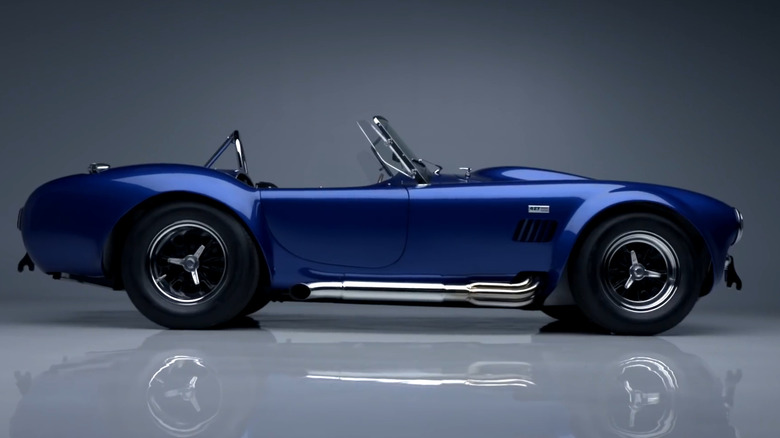5 Of The Most Dangerous Classic Supercars You Can Drive
Provided you have a license, there is no reason you can't hop in a supercar and start driving. At least, in a normal, considerate manner. If you want to test its limits, you'll need some training. After all, supercars today approach 1,000 hp, which is too much for most drivers. Predictably, many supercar manufacturers offer special driving schools for their customers.
Even so, modern supercars are easier to drive than they were before. Most are equipped with driver aids to help you put the power to the ground more easily and keep things stable in the corners. Not to mention, most have automatic transmissions and come with significantly grippier tires. With classic supercars, though, you were left on your own.
Some classic supercars are notorious for being dangerous to drive. Overpowered and without any driving aid, these machines weren't for the faint of heart. Some of these models were also underdeveloped in crucial areas, like suspension and aerodynamics. Either way, they caught drivers by surprise, and in some cases, took along sacrifices. Strap in and hold tight, because these classic supercars are ruthless!
Porsche Carrera GT (2003 to 2006)
Perhaps there is no better supercar to start this list with than the Porsche Carrera GT. This V10 beast has become mythical for all the good and bad reasons. On one side, it's praised as one of the best-ever supercars. It was the first supercar with a carbon-fiber monocoque chassis and an open rooftop. Its racing-derived 5.7-liter is one of the best-sounding V10 engines ever made. Oh, and Porsche positioned it behind the driver for better handling. The six-speed manual only added to the Carrera GT's unique driving experience. With 603 hp and 435 lb-ft on tap, it also out-accelerated most supercars in its era, reaching 60 in just 3.5 seconds.
Yet, the Carrera GT is also one of the most notorious supercars ever made. Beloved actor Paul Walker died after his friend Roger Rodas infamously crashed a Carrera GT in 2013. Most probably, the reason was the old tires, but Roger also drove between 80 and 93 mph in a 45-mph zone. Still, the Carrera GT can be a very challenging car to drive. Due to its mid-engine configuration, it had a tendency for snap oversteer, which was exaggerated by the absence of an electronic stability control (ESC). Also, while the stick shift was fun, it was another thing to worry about in an already challenging package.
The snap-oversteer issue is so well-documented, in fact, that Porsche launched new Michelin Pilot Sport Cup 2 tires for the Carrera GT this year. According to the automaker, the new tires better communicate the loss of grip, resulting in a faster and safer driving experience.
Koenigsegg CCR/CCX (2004 to 2010)
Today, Koenigsegg is one of the most advanced car companies in the world. Not only does it build the fastest car in the world — the stunning (theoretical) 310-mph Jesko Absolut — but also world-first technologies. Instead of a dual-clutch, Koenigsegg uses a much more advanced multi-clutch, nine-speed Light Speed Transmission, which, in the CC850, can also function as a six-speed manual. Innovation for a more engaging experience — just how we like it!
But Koenigsegg wasn't as advanced when it first arrived. Yes, the Swedish automaker still produced incredibly fast cars. Koenigsegg's first effort, the CC8S, had a supercharged 4.7-liter V8 good for 655 hp, but things quickly got crazier with the brand's second car, the CCR, which produced 806 hp. Oh, and the performance figures were dizzying — the CCR sprinted to 62 mph (100 km/h) in just 3.2 seconds and had a top speed of an astonishing 242+ mph. The CCX, launched in 2006, provided similar performance but offered more interior space and complied with global safety and emission standards.
So, on paper, the CCR and CCX were some of the best cars of their era. Still, they had a glaring issue — insufficient downforce. And this was discovered by none other than Top Gear's The Stig when he ran the CCX in Series 8 Episode 1 on the show's racetrack and spun at high speed. Koenigsegg added a rear wing to increase downforce afterward, but with so much power sent to the rear wheels and a six-speed manual, the CCX remained a challenging car to drive.
Dodge Viper Gen 1 (1992 to 2002)
Speaking of a manual transmission supercar with a massively powerful engine, we must also mention the first-gen Dodge Viper. When this V10 monster arrived in 1991, it was so wild, it's hard to believe Dodge built it. Under its extra-long bonnet, Dodge implemented a huge 8.0-liter V10 designed in collaboration with Lamborghini, good for 400 hp and an astounding 465 lb-ft of torque. To give you a clearer picture of how ridiculous the torque figure was, the Ferrari F40 had 426 lb-ft, while the Lamborghini Diablo had 428 lb-ft of torque.
Even more impressive is the fact that most of the Viper's torque was available at 3,600 rpm. In other words, the first-gen Viper could spin the massive 335/35 R17 rear tires at the slightest touch of the acceleration pedal. And the manual transmission made things even worse. Due to Viper's soft engine mounts, the shifter moved off-center quite significantly, so instead of going from third to fourth, owners often selected second gear. This would send the rear wheels into a spinning frenzy and the Viper into centrifugal motion.
Oh, but the first-gen Viper also didn't have ABS or traction control. And when you eventually spun, there were no airbags to keep you safe. You'd expect that Dodge rectified all these issues with the refreshed 1996 Viper, but nah — all they did was add more power. For instance, the 1999 Viper ACR variant had 460 hp. So, somewhat predictably, the first-gen Viper is one of the most expensive vehicles to insure.
Shelby Cobra 427 Super Snake (1966 to 1967)
Perhaps no other car in history looked as shocking when it was introduced as the Shelby Cobra 427 Super Snake. In 1966, Jensen had just launched the first car with ABS, but of course, the feature wasn't available on the 427 Super Snake. Moreover, traction control wasn't even a thing back then, and tires were way less grippy.
Yet, Caroll Shelby equipped this tiny sports car with a massive 7.0-liter V8 with two superchargers! The result: 800 hp sent only to the rear wheels. This was an insane figure in 1966, particularly in a car that weighed just 2,550 pounds. As a result, despite having an antique three-speed automatic transmission, the Cobra 427 Super Snake accelerated to 60 in just 3.2 seconds.
Driving at the speeds the Super Snake is capable of without a roof over your head must've been frightening, to say the least. Comedian Bill Cosby convinced Caroll Shelby to build a second Super Snake, although the racing driver/automotive engineer only intended to build one example for himself. However, after a single drive in his new car, Cosby decided to sell it because it was so frightening.
It's good that he did, because for Tony Maxey, the wealthy automotive enthusiast who bought the car from Cosby, it proved fatal. Maxey drove his Cobra 427 Super Snake on a twisty Californian road, lost control, and fell off a cliff and into the Pacific Ocean. Several days later, he succumbed to the injuries. Interestingly, in 2021, a buyer paid $5.5 million for Shelby's only remaining Cobra 427 Super Snake, which was auctioned at Barrett-Jackson.
Porsche 930 911 Turbo Widowmaker (1975 to 1989)
Yup, Widowmaker is the official nickname of Porsche's first-ever 911 Turbo. Developed as a homologation special for the 935 Turbo racecar, the 930-generation Turbo remains one of the most challenging cars to drive. Why? Well, looking at the specs certainly doesn't do it justice. The first model had a turbocharged and air-cooled 3.0-liter flat-six that produced 260 hp (245 hp in the U.S.) and 253 lb-ft of torque. In 1978, Porsche upgraded it to a 3.3-liter unit with 300 hp and 304 lb-ft of torque, which could reach 60 mph in 5.4 seconds. Both came exclusively with a four-speed manual and RWD.
Nothing out of the ordinary, right? Wait until you hear about the notorious turbo lag. To put it bluntly, these engines were dead below 3,000 rpm. Then, they would start to tease you with something that corresponds to acceleration until 4,000 rpm, and — BANG! Once the turbocharger came on, the sudden rush of torque slapped your surprised face. That sure sounds like fun — on a straight road. In the twisties, though, it's trouble. The 930 911 Turbo would snap oversteer once that happened, catching even seasoned drivers off guard.
But it wasn't only the turbo. An engine located behind the rear wheels made Porsches historically difficult to drive. Oversteer was a thing on most 911s — particularly the 930 generation, which had no driving aids to help matters. Still, the turbo boost could turn this setback into a fatal or, at the very least, expensive disaster. Fortunately, Porsche learned from this — the latest 641-hp 911 Turbo S is strictly AWD.
